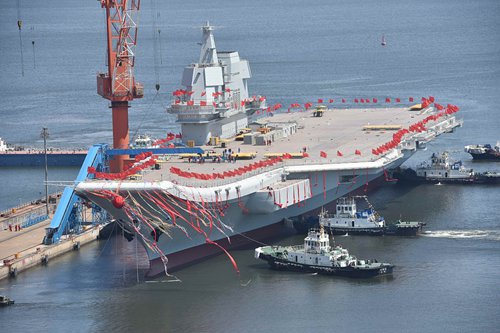Construction of China's 1st homegrown aircraft carrier ahead of schedule
Source
Editor
Zhang Tao
Time
2017-09-01
Type 001A undergoing final outfitting, system debugging
China's first homegrown aircraft carrier will soon undergo mooring trials, as outfitting work and system debugging are almost complete, the Chinese defense ministry spokesperson said.
Ren Guoqiang told the Global Times on Thursday that the construction of the Type 001A aircraft carrier is on schedule.
The Type 001A, which was launched on April 26, is being constructed in the coastal city of Dalian, Northeast China's Liaoning Province.
"Outfitting work and system debugging are being conducted, and mooring trials will soon begin," Ren said. Mooring trials are needed to test the carrier, including its power system, communications and radar. During the mooring tests, the ship will stay in the port.
Hu Wenming, the head and Party chief of China Shipbuilding Industry Corporation (CSIC) who visited Dalian Shipbuilding Industry Corporation (DSIC, the manufacturer of the Type 001A) in early August, praised the DSIC's work, saying the "key project" team has completed tasks ahead of schedule, according to the DSIC's website.
Although the website made no mention of the aircraft carrier, a photo shows the meeting of "the Party Committee Working Conference of 002 Aircraft Carrier" (002 is the project's codename).
On August 3, Hu, also the general director of the development of the first homegrown aircraft carrier, told CCTV that the Type 001A will start mooring trials ahead of schedule in September, which means it would only take the carrier five months to get to the mooring trial stage after its launch in April.
"Mooring trials normally take months since they need to fix identified problems and adjust the system, and if everything goes well, the mooring trials might only take about a month. Once the mooring trials are completed, the carrier can move on to its sea tests," said Beijing-based naval military expert Li Jie.
He said "the construction of the aircraft carrier is a huge project. More than 5,000 people worked on the carrier during the peak period. The people who contributed to the carrier's research and development are spread all over the country, including both State-owned military industry and civilian sectors."
Hu said that a total of 532 institutions have participated in the development of the carrier, with 412 of them non-military, including State-owned enterprises, private companies, scientific research institutes and universities, CCTV reported.

